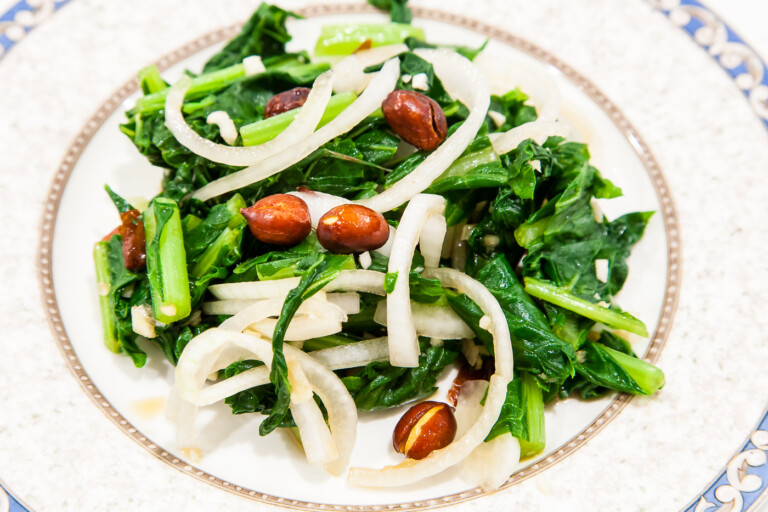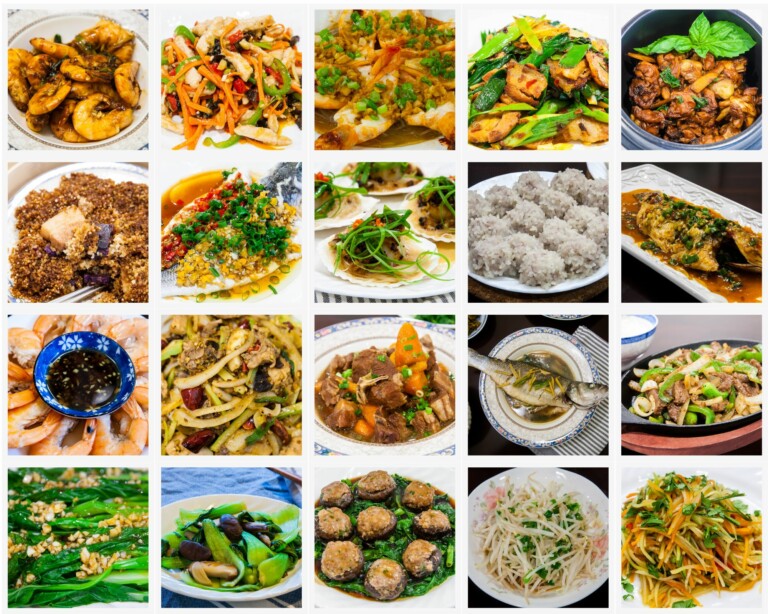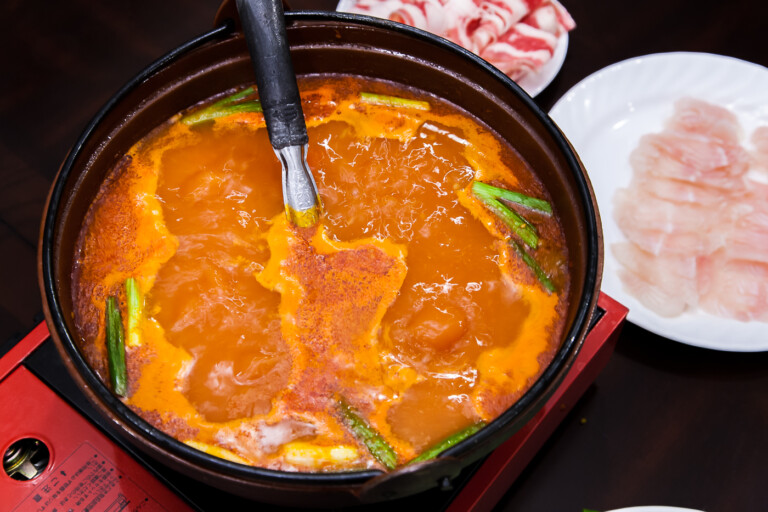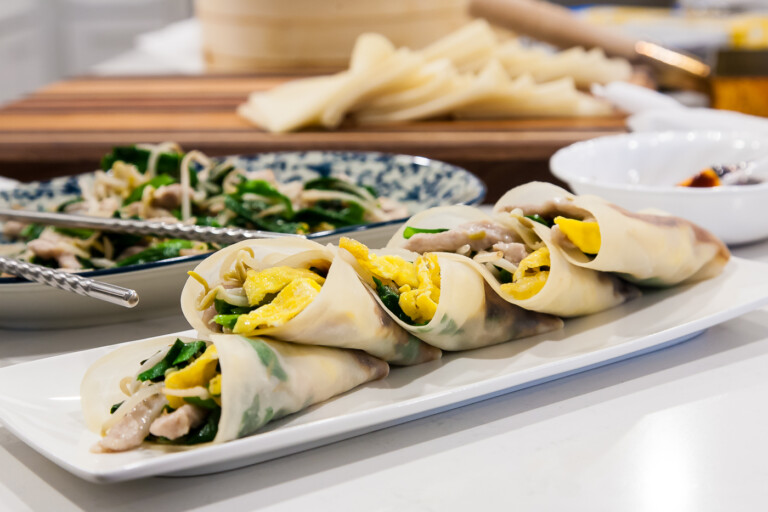
Chinese Hot Pot (火锅 Huo Guo)
February 4, 2023 Print
Earlier this month, I shared my recipe for one of my favorite hot pot soup bases. This article is a more in depth look into hot pot in general.
Hot pot (火锅) is a popular Chinese cooking method centered around a large pot with boiling stock/soup base. Plates of raw meat, seafood, vegetables, and/or starchy items are arranged around the boiling pot. A boil is constantly maintained to allow food items to be cooked and eaten continuously. Cooked hot pot items are often dipped in a sauce before consumption. No matter the type of hot pot, it’s always a busy sight with everyone cooking and eating at the same time, while liquid bubbles and hot steam rises from the hot pot.
If you read my previous post, tomato flavored hot pot soup base, you probably already know that I started eating hot pot (火锅) at a very young age—probably around 2 or 3. My paternal grandparents liked to make either hot pot or dumplings during the Chinese New Year/Lunar New Year. Back when I was little (in the 80s), the type of hot pot in Beijing was mostly northern-Chinese style. This is also known as instant-boiled mutton (涮羊肉). The cookware used for instant-boiled mutton had quite an interesting shape: almost like a huge bowl stuck onto an elongated cone. And the entire cookware was made of copper. When used, hot boiling stock fills the copper bowl and cooks the food. The heat used to keep the stock boiling comes from the charcoal in the lower half the copper “cone.” Smoke then escapes from the chimney on top of the “cone.” At the time of this article, Wikipedia has a nice article showing what a smaller version of the cone used for instant-boiled mutton looks like.
My grandpa’s used his own home version for the instant boiled mutton stock. It was just boiling water with some green onion, ginger, and goji berries. The mutton/lamb meat was the main focus. Coming from different parts of a lamb, the mutton/lamb meat had the perfect balance of fat and lean meats. Everyone would use his/her chopsticks to pick up a paper-thin piece of raw mutton and lower it in the boiling soup base. The meat became edible when its color changed from pink to white, which took only seconds. All the while, the meat was still being held by chopsticks. Then the meat was dipped lightly in a savory sauce made from mostly sesame sauce, leek flower sauce, and fermented bean curd. After being dipped, the meat was eaten right away. The meat was always melt-in-the mouth tender. Besides the mutton/lamb meat, there were usually only two to three non-mutton options: napa cabbages, tofu, and rice vermicelli. We would eat for hours during large family gatherings until everyone’s belt buckle needed to be loosened.
The copper pot that my grandpa used for instant-boiled mutton is almost an antique now. You can still find them in restaurants, although many instant-boiled mutton restaurants opt for much a smaller copper pot that’s designed for individual use. Charcoal has also been replaced by more friendly solid alcohol fuel.
It was several years later that I had my first Southern style hot pot in the city of Chongqing, Sichuan. It was called Chongqing hot pot (重庆火锅). At the time, I simply thought it was convenient for them to name the hot pot based on the name of the city. What little did I know as a kid! Unlike the instant boiled mutton (涮羊肉) soup base, the soup bases used for Chongqing hot pot are quite strong and flavorful. There are always plenty of herbs, seasoning, and colors in the soup base. The spicy soup base is particularly hot and numbing. I remember coughing and tearing profusely as a kid after eating from a spicy soup base. I had to down a whole bottle of cold water as a result. But I kept eating from the spicy soup base because it was so addictive.
Chongqing hot pot usually uses a large saucepan as the cookware. In restaurants, Chongqing hot pot often has one or multiple separators in the saucepan. The hot pot with one separator can hold two different soup bases. This type of two-soup-base hot pot is called Mandarin Duck hot pot (鸳鸯火锅) because Mandarin ducks are always in pairs. It’s great for people who want to enjoy two different flavors. The most common combination is a red (spicy) and white (non-spicy) combination.
Another interesting type of Chongqing hot pot is called 9 grid hot pot (9 宫格火锅). Even though there are 9 grids in the hot pot, the soup base in all 9 of the grids is the same. It is said that the 9 grid hot pot was invented due to scarce resources. It allowed strangers to eat from the same pot using his own individual grid. This type of arrangement made sense both economically and practically for people with limited resources. These days of course people only eat hot pot with friends and families, or at least people they know. They still use the 9 grids, but instead mainly to cook different foods. This helps to cook foods that have different temperature and time requirements. It also helps eaters find a particular food item more easily if they know its location within the grid.
There are quite a few other popular types of regional hot pot in China, but none are more prominent than the Chongqing hot pot and Instant-Boiled Mutton. Many other Asian countries also have their own version of hot pot. The soup base might have a unique flavor. There also might be some featured raw ingredients. The dipping sauce might be made with regional flavors. But no matter the type, the main preparation method is always the same.
You can find many different hot pot restaurants both within and outside of China. In the US, you can definitely spot hot pot restaurants in Asian-concentrated neighborhoods. Although it’s convenient to eat in restaurants, I find making hot pot at home a more pleasant and homey experience. It doesn’t even take much time to prepare everything, which makes hot pot a great choice for gatherings.
Below are what I generally include on my hot pot table. My husband is a seafood lover. So I include many seafood options. You can pick what you like based on your own preferences. There is no fixed formula. That’s one thing I love about hot pot. You pick food based on your own liking and eat at your own pace.
I just use a simple countertop butane stove with one of my saucepans for my hot pot, as you can see from the photos. But they also make great electric hot pots that work well if you have an outlet nearby.
For the soup base, you can use store bought soup base, or make your own. I posted a tomato flavored soup base recipe earlier this month. I’ve also simply used my homemade pork bone stock and chicken stock to make the soup base. I will definitely post more soup base recipes in the near future so you can try them out and see which one is your favorite.
For the dipping sauce, I prefer Sha-Cha sauce as the main sauce. This is also known as Chinese Barbecue sauce (沙茶酱). I pair it with some creamy peanut butter and sesame oil. For added flavors, I tend to add some chili crisps/sauce, a few drops of Chinese Chinkiang vinegar, a tiny bit of fermented bean curd, and some garlic paste. My version of the dipping sauce is more Southern in style. If you prefer a super simple dipping sauce that’s great for kids, you can just mix some sesame sauce with salt and sesame oil, or mix some Sha-Cha sauce with some sesame oil.
Low Carb
Preparation Time: 55 minutes (not including time for making homemade stock)
Total Time: 1 hour
Servings: 4 to 6 people
Ingredients:
Soup base options:
- tomato-flavored soup base
- pork bone stock, sliced ginger, green onions, goji berries, ground white pepper and salt
- chicken stock, sliced ginger, green onions, goji berries, ground white pepper and salt

Meat options:
- thinly sliced fatty beef slices
- thinly sliced lamb meat
- thinly sliced pork belly
- beef balls
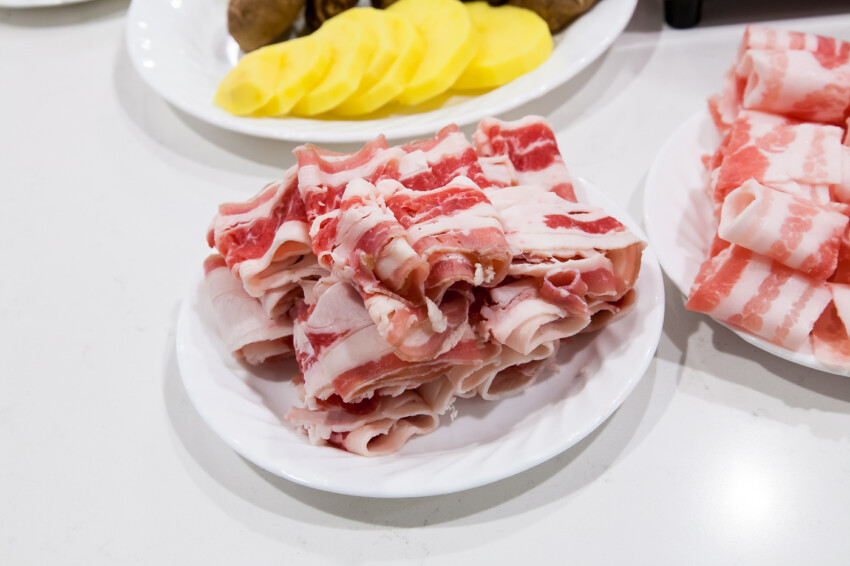

Seafood options:
- fish balls, assorted
- shrimp paste or balls
- fish tofu or fish cakes
- fresh clams and mussels, cleaned
- fish fillet (cut diagonally into 1/2 inch thick slices)
- raw shrimp, peeled and de-veined


Vegetable options:
- napa cabbage leaves, cut into large pieces
- Shanghai baby bok choy, cut into quarters lengthwise
- yellow potato, peeled and cut into thick slices
- dried shiitake mushrooms, re-hydrate
- fresh mushrooms, assorted


Other options:
- quail eggs
- eggs
- tofu (any kind), slice into thick pieces
- sweet potato vermicelli, semi-softened first


Dipping Sauce: (individual)
- 2 tablespoons Sha-Cha Chinese Barbecue Sauce (沙茶酱) 1
- 1 teaspoon creamy peanut butter (花生酱) or tahini 2
- 1 tablespoon sesame oil
- 1/2 teaspoon Chinese black (Chinkiang) vinegar (optional)
- 1 teaspoon chili crisps or sauce (optional)
- 1 teaspoon minced garlic or garlic paste (optional)
- 1/2 teaspoon fermented bean curd (腐乳) (optional) 3


Preparation:
- Soup base: for a tomato flavored hot pot soup base, follow my recipe in Hot Pot Soup Base (Tomato Flavor). For a simple homemade pork bone stock or chicken stock soup base, simmer the stock with some slices of ginger and chopped green onions for 20 minutes in a hot pot pan or sauce pan . Then add some goji berries, a splash of ground white pepper, and salt to taste. There are also store bought soup base options if you are pressed for time.

- Ingredients: neatly lay ingredients on plates according to their categories. For seafood—like fish balls, fish cakes, fish tofu, and shrimp balls—you do not need to thaw it before hand. Only rinse and separate them into individual pieces. For vegetables, wash and cut according to the recommendations in the ingredients section.

- Dipping Sauce: mix 2 tablespoons of Chinese barbecue sauce with 1 teaspoon of creamy peanut butter, and 1 tablespoon of sesame oil. For optional added flavors, add ½ teaspoon of Chinese black (Chinkiang) vinegar, 1 teaspoon of chili crisps or sauce, 1 teaspoon of minced garlic or garlic paste, and/or ½ teaspoon of fermented bean curd.

- Center the hot pot on the table. If you have a countertop butane stove, put the pot with the soup base directly on top of the countertop butane stove. If you have an electric hot pot, prepare the soup base first on the stove then add it to the electric hot pot. Surround the hot pot with the plates of prepared ingredients. When the soup base in the hot pot starts bubbling, add a few ingredients from each category (or whichever you prefer to eat first) to the hot pot. The meat and seafood (like raw shrimp and fish fillets) become edible when they change color, which takes very little time. Ingredients like beef/fish/shrimp balls and fish tofu become edible when they float on top. Most vegetables do not require much cooking time. There are, of course, exceptions like potato and pumpkin. Tofu can either be cooked for a short period or for a long time based on personal preferences. Dip the cooked ingredients in the prepared dipping sauce and enjoy your hot pot! You can also serve yourself a bowl of the soup, straight from the pot, either at the beginning or towards the end. Note that the soup does tend to become more salty as more ingredients are cooked over the course of your meal.

Bon Appétit

Notes:
- You can get Sha Cha or Chinese Barbecue sauce (沙茶酱) from most Asian grocery stores. It’s also available at some Asian online gocers. To learn more about Sha Cha sauce, refer to my Okra Shrimp Fried Rice article.

- Use sesame or tahini sauce if you are allergic to peanuts.
- You can find fermented bean curd (豆腐乳) in most Asian grocery stores. There are many kinds from different regions, which can be overwhelming for someone who’s never had it. In my opinion, they all taste similar, with minor differences. Some are sweeter or saltier than others. As long as you don’t choose stinky fermented bean curd (臭豆腐乳), you should be fine.
As an Amazon Associate I earn from qualifying purchases.








